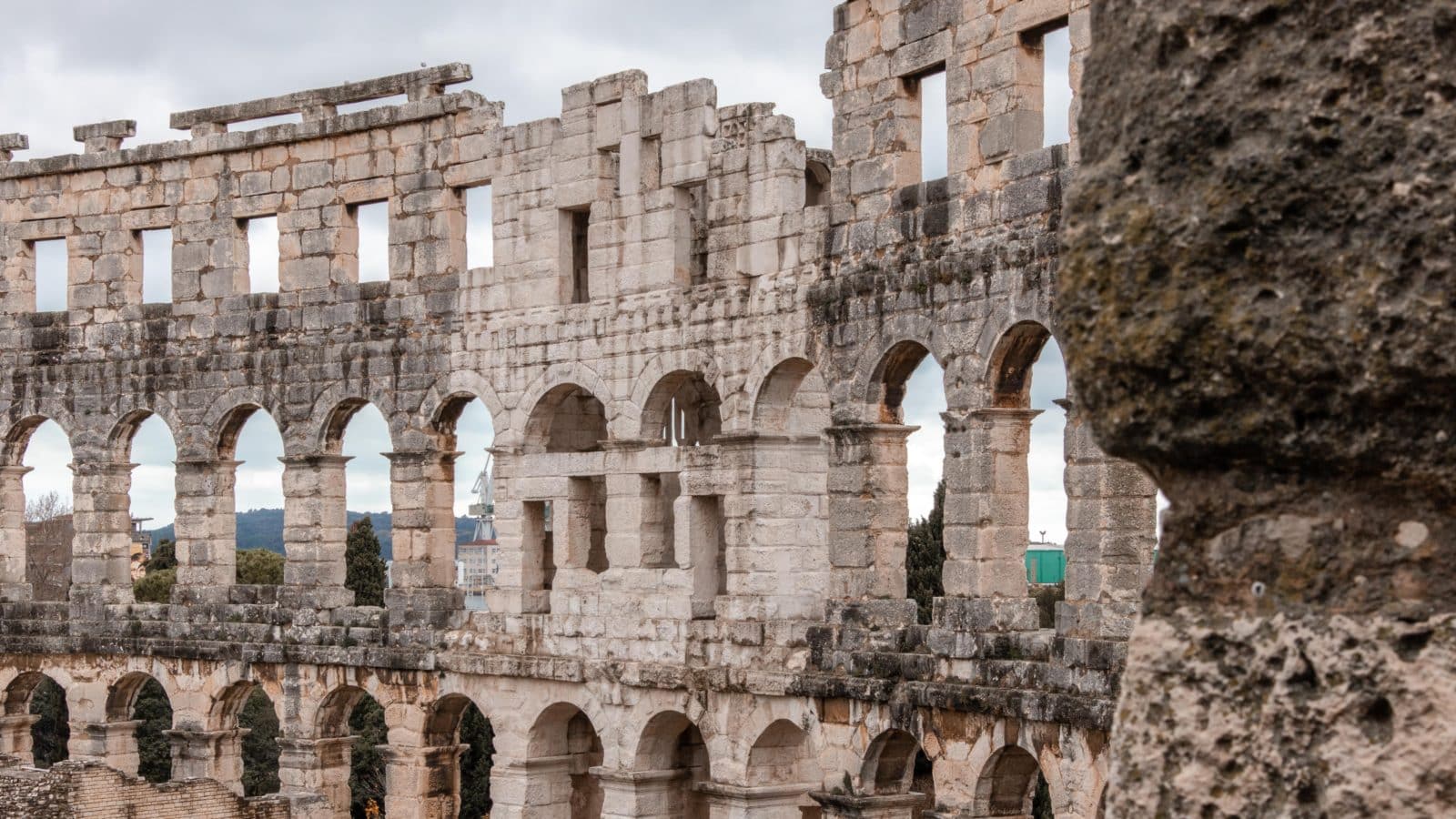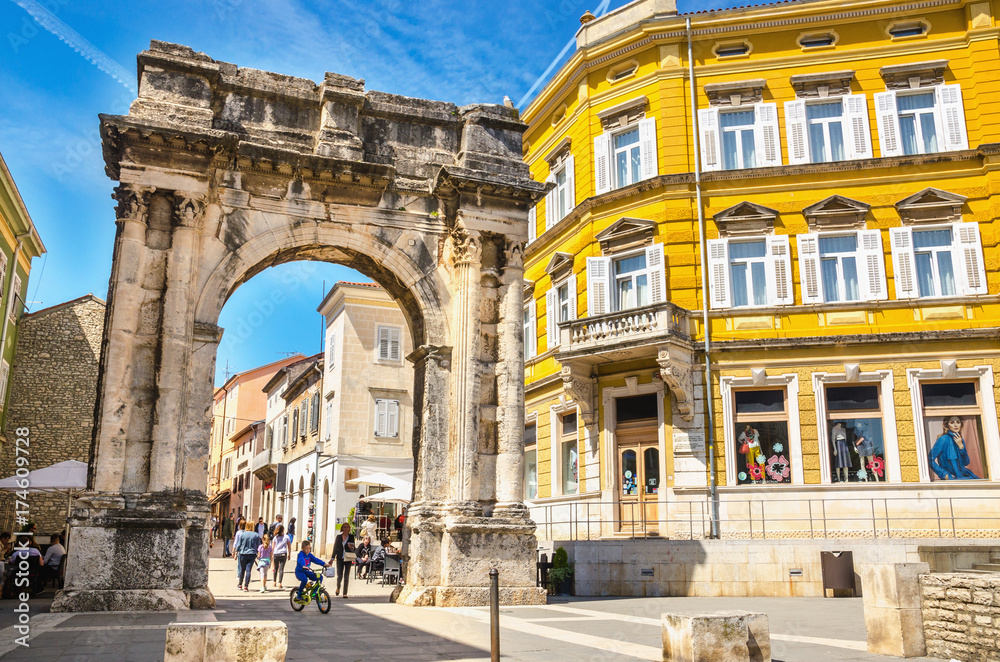Pula is a modern city with rich history and a multitude of cultural monuments.
Familiarize yourself with the most important sights before your vacation.
- Roman Amphitheatre
Pula’s most famous and imposing sight is this 1st-century oval amphitheatre, overlooking the harbour northeast of the old town. It’s a huge and truly magnificent structure, slotted together entirely from local limestone and known locally as the Arena. Designed to host gladiatorial contests and seating up to 20,000 spectators, it still serves the mass-entertainment needs of the local populace in the shape of concerts and film-festival screenings.
At 133m long, 105m wide and 32m high, Pula’s amphitheatre is the sixth largest of its kind. On the top of the walls is a gutter that collected rainwater, and you can still see the slabs used to secure the fabric canopy, which protected spectators from the sun. You can get a decent view of the Arena from just walking around the outside, but the entrance fee enables you to clamber around the stones and visit the underground chambers. Once used to house the wild beasts and to drag away dead gladiators, they now contain rather more genteel displays of amphorae and equipment used in the production of olive oil.
In summer, check out the Spectacvla Antiqva (adult/child 80/40KN), an evening event held at least once a week, featuring gladiator fights and Roman-style clothing, hairstyles, food and drinks.

2. Temple of Augustus
Fronted by a high porch supported by six Corinthian columns, this small but perfectly proportioned temple was built sometime between 2 BC and AD 14. It survived the Christian era by being converted into a church, only for it to be destroyed by a bomb in 1944. The subsequent stone-by-stone reconstruction has brought it back to something closely approaching its former glory, and it now houses a small archaeological display.
It was once one of a pair of matching temples fronting the Forum – the civic heart of Roman and medieval Pula – but all that survives of its twin, the Temple of Diana, can be seen incorporated into the rear wall of the 13th-century city hall next door.

3. Archaeological Museum of Istria
By collecting stone monuments in the Temple of Augustus in 1802, marshal Marmont began the founding of the museum collection in Pula. However, the discovery of stone, ceramic and metal objects in Nesactium was the basis for founding the Museo Civico (City Museum) in Pula in 1902. After the seat of the “Società istriana di archeologia e storia patria” had been moved and with the transfer of the archaeological inventory from Poreč to Pula, the Museo Civico was integrated with the National collection (stone monuments) and the Poreč Regional Museum (Museo Provinciale) into one regional institution. Therefore, in 1925 the Museum of Istria (Il Regio Museo dell’Istria) was founded in the present-day museum building. In 1930 the museum opened its doors to visitors, and a guidebook in Italian was published. This exhibition, along with minor changes, was open for the public until the end of World War II, when many objects were transferred to Italy during the Anglo-American administration.
After some modifications in the collection of stone monuments and having displayed the remaining exhibits, in 1949 the museum reopened as the specialized Archaeological Museum of Istria. By systematic work and with great efforts, after having restituted part of the archaeological objects from Italy in 1961, the museum building was gradually renovated and the museum exhibits displayed in a representative didactical-visual concept. The reconstructed collection of stone monuments on the ground floor and museum halls reopened in 1968. In 1973 the prehistoric room on the 1st and the classical, late Roman and medieval exhibits on the 2nd floor of the museum opened.
The museum halls of the Archaeological Museum of Istria are constantly being extended; supplemented with new finds from archaeological sites in Istria (prehistoric caves, hill forts and necropolises, Roman economic complexes, buildings and cemeteries, as well as sacral edifices from the early Christian and Byzantine period, the barbaric invasion and the settlement of the Slavs in Istria).
4. Triumphal Arch of the Sergi – Golden Gate
The “Golden Gate” was erected between the years 29 and 27 BC by the Sergi family, in honor of three members of the family who held important positions in Pula at that time. This triumphal arch leaned against the city gate Porta Aurea thus called because of its richly ornamented arch or gilded elements. The gate and wall were pulled down in the beginning of the 19th century as a result of the city expansion outside the city walls.
The Arch was constructed in Corinthian style with strong Hellenistic and Asia Minor influences both in the method and ornaments. As the eastern side was not visible it has remained for the most part uncarved, while the western, town side is richly decorated. Today numerous cultural performances, theatrical and musical, are held on the square next to the Arch. The adjacent street is a shopping area.

5. Castle
From the upper circular street one of the perpendicular paths leads to the top of the central hill of the city where a star-shaped castle with four bastions was built in 1630. Wishing to protect the city and its harbor, because of it great significance in maritime trade in the North Adriatic, the Venetians commissioned the building of the Castle from the French military architect Antoine de Ville. This was most probably the site of an earlier fortress dating from the pre-Roman and Roman period. The Histrian hill-fort was primarily built for defensive purposes, whereas in the Roman period a small military garrison was stationed here. Today the Castle houses the Historical Museum of Istria.
Things to do
